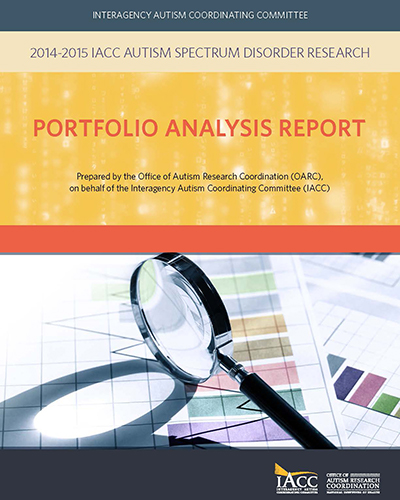Portfolio Analysis Report
IACC Autism Spectrum Disorder Research
2014-2015
The 2014-2015 IACC ASD Research Portfolio Analysis Report represents the eighth year of data collected and the sixth comprehensive report of U.S. ASD research funding across both the Federal and private sectors; it will also be the last analysis to measure research progress against the objectives from the 2011 IACC Strategic Plan. Future portfolio analyses will monitor new objectives created in the 2016-2017 IACC Strategic Plan. For this analysis on the 78 objectives from the 2011 IACC Strategic Plan, data were collected from 18 Federal and private funders. The diverse missions of the different funders are reflected in the ASD research portfolio across the seven questions of the Strategic Plan. In 2015, federal agencies continued to fund four-fifths of ASD research while private organizations contributed nearly 20% of funding. Among the participating funders, National Institutes of Health continued to contribute the largest amount of Federal funding toward autism research, and the Simons Foundation was the largest private funder.
Overall, funding for ASD research among both Federal and private funders totaled $309.9 million and spanned 1,441 projects in 2014 and reached $342.6 million covering 1,410 projects in 2015. With eight years of ASD research funding data available, it was possible to continue analyzing funding trends, enabling meaningful observations about the long-term progress of the field of ASD research over the period from 2008-2015. Over the eight years, autism research showed a general upward trend in funding, increasing by 54% since 2008.
One of the key aims of the Portfolio Analysis Report is to evaluate the progress made in addressing the research priorities as outlined in the Strategic Plan objectives. In 2015, significant progress was made toward completing the objectives in the 2011 Strategic Plan, with 97% (76 objectives) of the 78 objectives either partially or fully completed. Considering the period from 2008-2015, only 3% (2 objectives) of the 2011 Strategic Plan objectives were not active at any point across this eight-year window. This indicates that the vast majority of priority areas identified in the Strategic Plan objectives were deemed by Federal and private research funders to be worthy of investment and were implemented either partially or fully. While broad implementation efforts across most of the Strategic Plan objectives demonstrated commitment of Federal and private funders to pursuing the research areas prioritized by the Committee, many areas of partial funding still left significant gaps that were not filled over this period. Further attention and additional funding may be needed in the future to stimulate and develop more robust research efforts in those areas. The Committee has taken these gaps into consideration in the development of the forthcoming 2016-2017 IACC Strategic Plan.
In addition to analysis of progress made on completing the specific research objectives outlined in the Strategic Plan, the subcategory classification system, introduced in the 2010 Portfolio Analysis, continues to provide an alternative perspective on the content of the autism research portfolio. Even with future changes in Strategic Plan objectives, the subcategory analysis will allow tracking of growth and change in general research areas over time, including the emergence of new fields that attract investment from research funders.
As in the 2013 IACC ASD Portfolio Analysis Report, additional analyses on the geographical distribution of autism research funding, investments in long-term (ongoing) research compared to newly funded projects, and the types of research funded by different agencies and organizations were included in the portfolio analysis to provide more detailed information for the Committee and community stakeholders on the autism research landscape.
This annual IACC ASD Research Portfolio Analysis Report assists the Committee with carrying out its charge to monitor autism activities and to inform the process of updating the IACC Strategic Plan for ASD Research. While this is the last portfolio analysis using the Strategic Plan objectives developed in 2011, in the next IACC Strategic Plan (2016-2017), the Committee will put forward objectives and budget recommendations to encourage funders to direct investment toward a new set of research priorities that reflect the most pressing needs of the autism community and incite greater attention to the needed autism research areas. Future portfolio analyses using the 2016-2017 IACC Strategic Plan’s new objectives will continue to serve as a resource for the Committee, funders, and the broader ASD community to identify and address knowledge gaps, recognize emerging trends and new opportunities, and guide future research priorities to better meet the needs of families and individuals affected by ASD.




